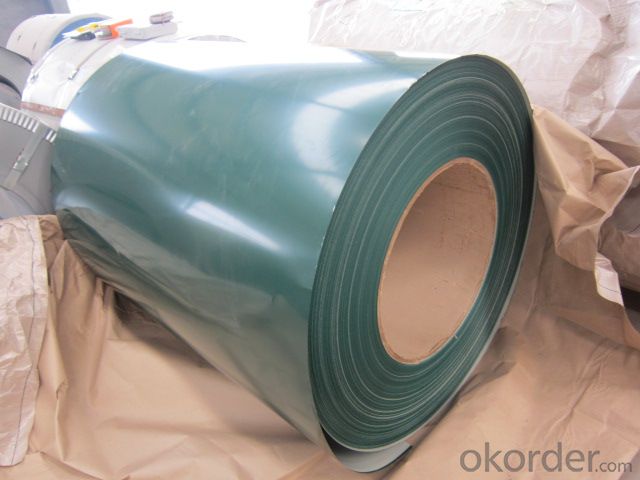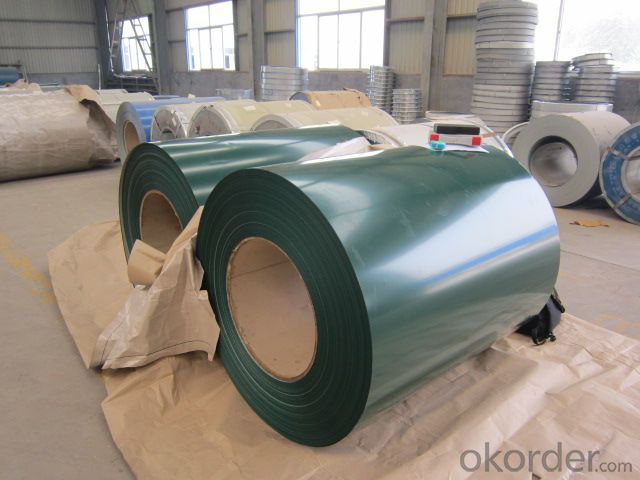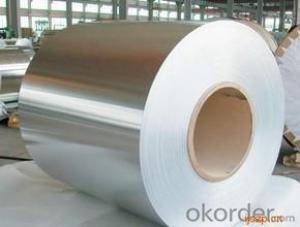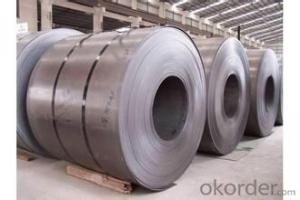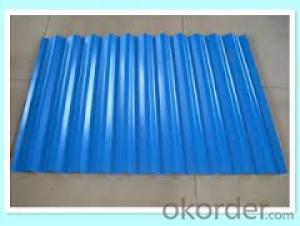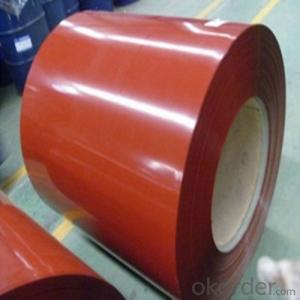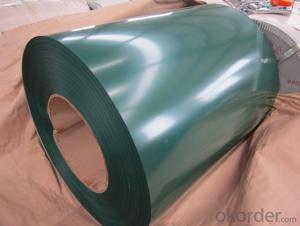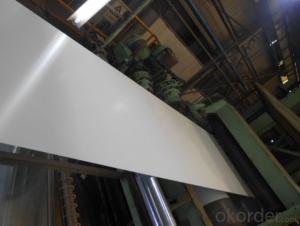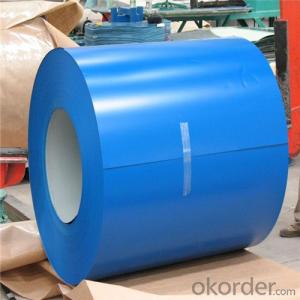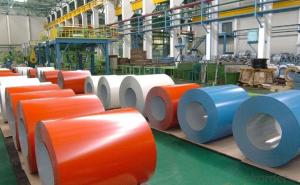Pre Painted Galvanized Steel Coil in Coils
- Loading Port:
- Tianjin
- Payment Terms:
- TT OR LC
- Min Order Qty:
- 50 m.t.
- Supply Capability:
- 5000 m.t./month
OKorder Service Pledge
OKorder Financial Service
You Might Also Like
Description:
Pre-Painted Steel Coil is coated with organic layer, which provides higher anti-corrosion property and a longer lifespan than that of galvanized steel sheets.
The Pre Painted Steel Coil can also be classified into groups by their surface textures, namely regular prepainted sheets, embossed sheets and printed sheets.
The production process has evolved from one-coating-and-one-baking to double-coating-and-double-baking, and even three-coating-and-three-baking.
The base metals for Pre Painted Steel Coil consist of cold rolled, HDG electro-galvanized and hot-dip alu-zinc coated steel. The finish coats of Pre Painted Steel Coil can be classified into groups as follows: polyester, silicon modified polyesters, polyvinylidene fluoride, high-durability polyester, etc.
Application:
It’s suitable for indoor or outdoor decoration, color lasting for at least 10 years for outdoor using, could for roll forming., conditioning, micro-wave oven, bread maker,solar water heater,condencing apparatus,Blackboard, white board,chalkboard, hidden cell blackboard,bulletin board,Central heating slice, lampshade, chifforobe, desk, bed, locker, bookshelf,garbage can, billboard, typewriter, instrument panel, weight sensor, photographic equipment,coffin, fence, Prepainted Galvanized Steel Coil
Electrical appliance:Refrigerator, washer, switch cabinet, instrument cabinet, air
Product Specification:
Color pre painted steel in coil
Thickness: 0.3-0.8mm
Width: 914-1250mm
Inner Diameter: 508mm,610MM
Weight of Steel Coil: 3-8MT
Available Dipped Layer: 50-150g/m2
Coating Type: Al-Zn Alloy
Paint: PE or PVDF
Available Surface Treatment: Passivating & Oiling & AFP & Filming
Type of coating structure: 2/1 Coat the top surface of the steel sheet twice, coat the bottom surface once, and bake the sheet twice.
Front Side Paint Thickness: 15-25μm
Back Side Paint Thickness: 5-10μm
STANDARD:JIS G3312,CGCC
FAQ:
1.Could you tell me the package for the Pre Painted Steel Coil?
Usually Standard export seaworthy package: waterproof paper+steel trip packed+wooden case seaworthy package
2.How about the color of the Pre Painted Steel Coil
The color of the Pre Painted Steel Coil has a very wide selection, like orange, cream-colored, dark sky blue, sea blue, bright red, brick red, ivory white, porcelain blue.
3. Can you produce the goods according to our requirements?
Yes, of course, it can be customized according to customer’s requirements.
Protective film can be provided according to customer if you needs.
- Q: What is the shelf life of a steel coil?
- The shelf life of a steel coil largely depends on various factors such as the type of steel, the storage conditions, and any protective measures taken. Generally, steel coils can have a shelf life ranging from a few months to several years. If the steel coil is properly stored in a controlled environment with suitable temperature, humidity, and ventilation, it can last for a longer period. Additionally, if the coil is coated with protective materials such as oil or anti-corrosion coatings, it can further extend its shelf life. However, if the steel coil is exposed to unfavorable storage conditions like high humidity, extreme temperatures, or corrosive substances, its shelf life can significantly decrease. Exposure to moisture and oxygen can lead to rust and corrosion, reducing the quality and structural integrity of the coil. To maximize the shelf life of a steel coil, it is essential to store it in a dry, well-ventilated area, away from direct sunlight and corrosive substances. Regular inspections and maintenance, including cleaning and re-application of protective coatings, can also help preserve the coil's quality. Ultimately, it is crucial to consult the manufacturer or supplier of the steel coil for specific shelf life recommendations as different types of steel may have varying durability and storage requirements.
- Q: So I'm trying to decide which is better. I've always had aluminum on my 6 yr old tb gelding as I do hunters on him. He's never had steel on but I've recently moved and the shoer here is more expensive. So is aluminum really worth the extra cash to keep him light on his feet or is steel really not that much different?
- IMO, steel is fine. The only time I've felt that aluminum was important was: 1. A horse with a specific shoeing issue that required an aluminum shoe. 2. A racehorse-- every micro-gram counts. 3. Top level pleasure horses who need a little bit flatter knee. Everything else I've seen did just fine in regular steel shoes.
- Q: How are steel coils used in the production of metal containers?
- Due to their versatility and strength, steel coils find wide application in the production of metal containers. Each stage of manufacturing metal containers relies heavily on steel coils. To begin with, steel coils serve as the primary raw material for metal container production. These coils consist of high-quality steel that is rolled into a continuous sheet, ensuring consistent thickness and durability. Subsequently, this sheet is cut into specific widths and lengths according to the container size requirements. Once the desired dimensions are achieved, various techniques are employed to shape the steel coils into container form. Roll forming, for example, is a commonly used method where the steel coil passes through a series of roll dies that gradually shape it into the desired container shape. This technique allows for the creation of containers in different sizes and designs, ranging from cans and drums to large industrial containers. After the initial forming process, the steel coils undergo further processing to enhance their strength and durability. Heat treatment is one such process where the coils are exposed to high temperatures to increase their hardness and resistance to wear and tear. Additionally, annealing and quenching methods may be employed to improve the steel's properties. Once the containers are formed and processed, additional fabrication steps, such as welding or sealing, are carried out to ensure their structural integrity. Steel coils are frequently utilized in these processes as they provide a robust and dependable material for creating sturdy seams and joints. Finally, metal containers receive various coatings or treatments to protect them from rust, corrosion, and other environmental factors. Steel coils can be coated with materials like paint, epoxy, or zinc to enhance their resistance to these elements, ultimately ensuring the longevity of the containers. In conclusion, steel coils play a crucial role in the production of metal containers. They serve as the primary raw material, aid in forming, processing, and finishing, and provide the necessary strength, durability, and versatility required for manufacturing reliable metal containers across a range of industries.
- Q: How are steel coils used in the manufacturing of pipelines?
- Steel coils are used in the manufacturing of pipelines by being formed into large cylindrical shapes that serve as the main body of the pipelines. These coils are unrolled and then welded together to create a continuous pipeline, providing strength and durability to transport fluids or gases over long distances.
- Q: What are the dimensions of steel coils used in the power generation industry?
- The dimensions of steel coils used in the power generation industry vary depending on the specific application and requirements. However, common dimensions for steel coils used in this industry are typically in the range of 0.5 to 3.0 millimeters in thickness and 600 to 2000 millimeters in width. The length of the coil can vary, but it is often in the range of several hundred to several thousand meters.
- Q: Can steel coils be coated with anti-graffiti materials?
- Yes, steel coils can be coated with anti-graffiti materials. These materials are designed to prevent graffiti from adhering to the surface of the steel coil, making it easier to remove any graffiti that may be applied.
- Q: How do steel coil manufacturers meet customer specifications?
- Steel coil manufacturers meet customer specifications by carefully analyzing the requirements provided by the customer and utilizing advanced production techniques to ensure precise dimensions, mechanical properties, and surface finishes. They employ strict quality control measures throughout the manufacturing process, including rigorous testing and inspections, to ensure that the coils meet the specified standards. Additionally, manufacturers often collaborate closely with customers to understand their unique needs and provide customized solutions that meet or exceed their expectations.
- Q: What are the different grades of steel used in coil production?
- There are several grades of steel used in coil production, including low carbon steel, high carbon steel, stainless steel, and galvanized steel. Each grade has its own unique properties and is chosen based on the specific requirements of the coil application.
- Q: What is the standard diameter of steel coils?
- The standard diameter of steel coils can vary depending on the specific industry and application. However, in general, the standard diameter of steel coils typically ranges from 24 inches to 72 inches. This range allows for easy handling, transportation, and storage of the coils. It is important to note that different industries may have their own specific requirements for steel coil diameters based on factors such as equipment compatibility, production processes, and logistical considerations.
- Q: Explain your answers please. I was watching mythbusters and they bought a steel coffin over a wooden one because they thought it would hold more dirt. Now how come bridges that have been made of wood lasted way longer than steel bridges? Or rollercoasts for example.
- Back when I was in school we used to have a contest comparing balsa wood bridge designs. The idea was to build the strongest bridge when derated for bridge weight. The strength test was that the 2-ft long bridge was placed between two tables and a garbage can was strung up to the middle of it. Then it was slowly filled with water until the bridge snapped. The can was weighed and divided by the bridge weight to get our scores. I don't see why you couldn't do this to compare wood vs steel. You could find how much load is needed to snap sample rods. The important point is that the rods should be nearly identical in dimensions between the two materials-- this means length and diameter. Also if you're measuring steel, you'd want to choose a relatively thin diameter or a long span or you won't be able to even bend it. Also while I'm pretty sure wood will snap, steel might bend gradually, so you'd have to decide how much deformation you would allow before calling the piece failed. Also if you take this approach be sure to wear safety glasses when running it. In fact it would be a good idea to put a metal shroud around the test structure.
Send your message to us
Pre Painted Galvanized Steel Coil in Coils
- Loading Port:
- Tianjin
- Payment Terms:
- TT OR LC
- Min Order Qty:
- 50 m.t.
- Supply Capability:
- 5000 m.t./month
OKorder Service Pledge
OKorder Financial Service
Similar products
Hot products
Hot Searches
Related keywords




